The Google Nexus 5X Review
by Brandon Chester on November 9, 2015 8:00 AM EST- Posted in
- Smartphones
- LG
- Mobile
- Android 6.0
- Nexus 5X
GPU Performance
CPU performance is one side of an SoC, while GPU performance is the other side. With two years of GPU development between the Nexus 5 and the 5X we're hopefully looking at a substantial uplift in GPU performance. Qualcomm's official figures peg Adreno 418 as 20% faster than Adreno 330 in graphics workloads. To characterize the Nexus 5X's performance during graphics workloads that are similar to those a 3D game would provide I've run it through our standard GPU-focused benchmarks. The first is 3DMark, followed by BaseMark X and GFXBench 3.0.

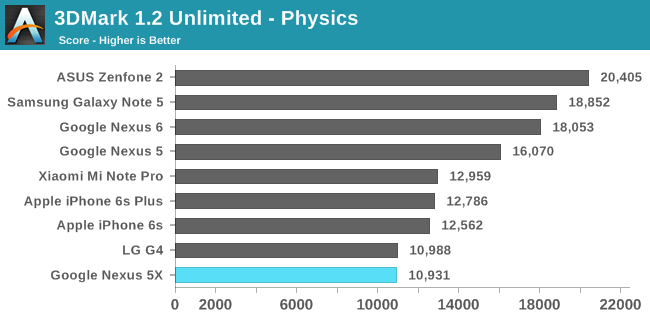
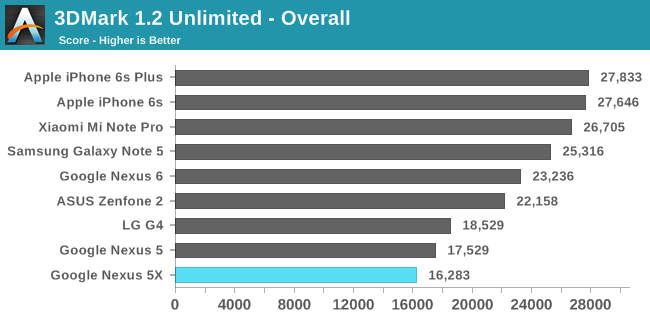
The Nexus 5X ends up actually coming in below the Nexus 5 in 3DMark's overall score. This is the result of the much lower score in the physics sub test. However, it's worth noting that the 3DMark physics test has heavy data dependencies and all of our tested devices with bigger out of order cores end up doing poorly. While this is a possible scenario in a real-world program, I wouldn't make too many conclusions from the Nexus 5X's performance here. In the graphics test there's actually a surprising gap between the 5X and the LG G4 which uses the same SoC, and I've been unable to get a score anywhere near it no matter how many times I re-run the test. At least in 3DMark it looks like the LG G4 has a bit of a lead over the Nexus 5X.
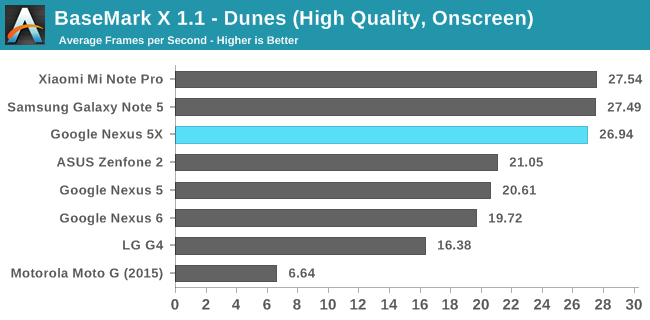
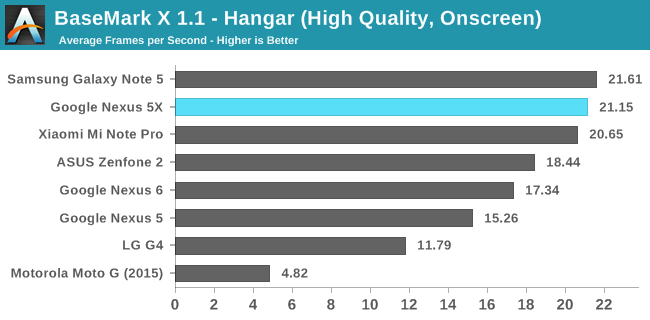
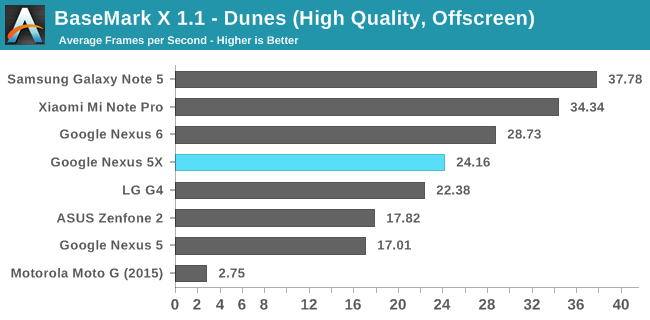
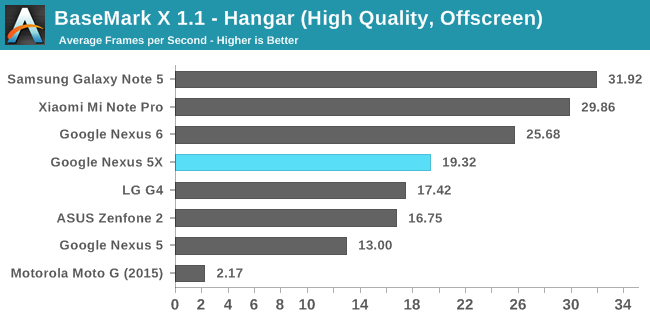
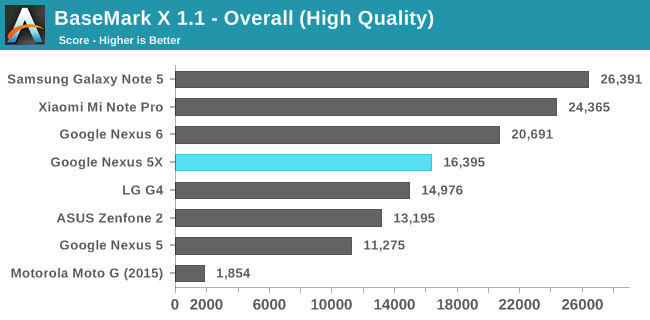
BaseMark X's results are more in line with what I expected to see from the 5X's GPU. The on-screen results are far ahead of the LG G4, which isn't surprising at all when you consider that the G4 is driving a 2560x1440 panel while the 5X is pushing 1920x1080. Both off-screen results are close enough that they could be ascribed to margin of error, and ultimately BaseMark X shows that there's not really any gap between the absolute performance of the G4 and the 5X, but the 5X will definitely be faster for anything running at native resolution.
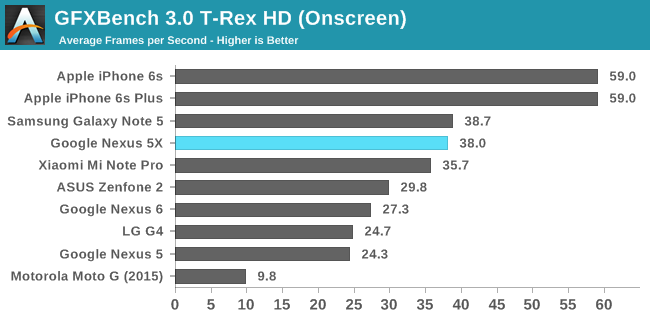
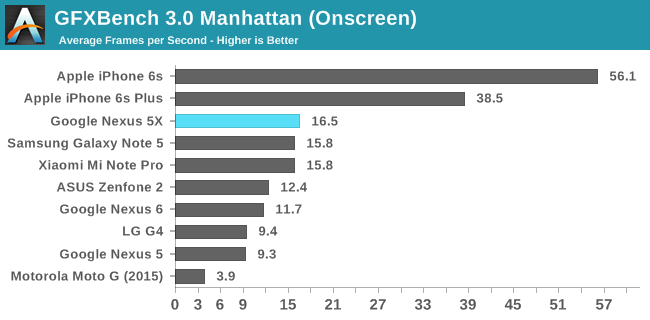

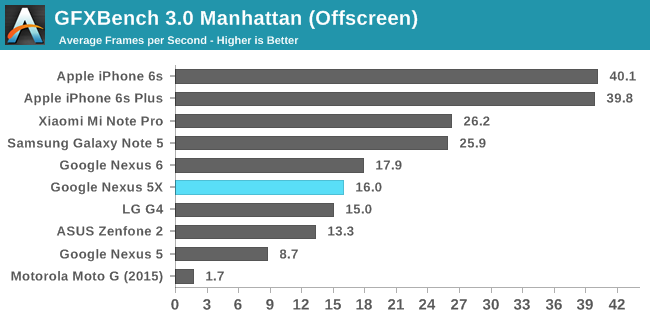
The results in GFXBench echo those of BaseMark X. The 5X beats the G4 in both off-screen cases, but only by a small margin. With the 5X being slightly faster than the G4 in both GFXBench and BaseMark X we may be looking at some small driver improvements here, but since all the gaps are so small it may just be coincidence that the 5X is the faster of the two devices in both tests.
Ultimately, both Adreno 418 and 430 are pretty good GPUs, and with the Nexus 5X being priced at $379 I think it offers more than adequate GPU performance for its price. What's interesting is that even though we didn't see Snapdragon 805 show up in many devices, it was in the Nexus 6, and its Adreno 420 GPU is definitely a bit faster than the Adreno 418 in the 5X. The Nexus 6 was also priced much higher than the 5X, and so with the 5X you're definitely getting a lot more GPU performance for your money than you got with the Nexus 6. The performance uplift is definitely greater than Qualcomm's stated 20%, and it's always nice to see something beat expectations.
NAND Performance
When I originally reviewed the Nexus 6 I decided to publish the review without any storage benchmarks, because in my testing I noticed that the results I was getting simply did not add up. Futher investigation revealed that it was the result of the Nexus 6's forced Full disk encryption (FDE), and the encryption and decryption of data being done without the use of high speed, power efficient fixed-function hardware. Later on in the Nexus 9 review Josh noted that there was a significant uplift in NAND performance compared to the Nexus 6, and it was clear that the AES/SHA instructions that are part of the ARMv8 instruction set were helping to reduce the performance impact of FDE.
Since Snapdragon 808 supports the ARMv8 ISA this presents a good opportunity to revisit this topic. The Nexus 5X shares several things with the LG G4, and one of them is its NAND, which is an eMMC 5.0 solution provided by Toshiba with the model number 032G74. While there's not much public information on this storage solution, one would expect that NAND storage speed results from the Nexus 5X closely match those of the LG G4, as if that isn't the case then it's clear that FDE causes a noticeable loss of performance despite ARMv8's cryptographic instructions.
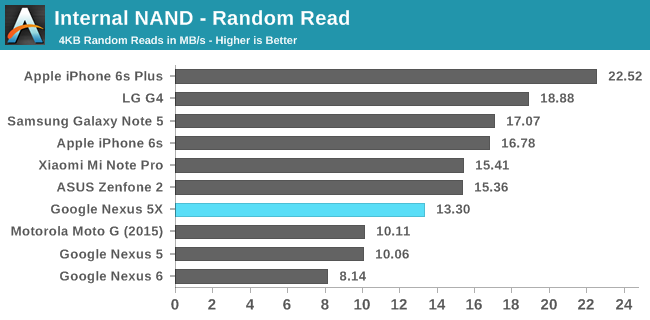
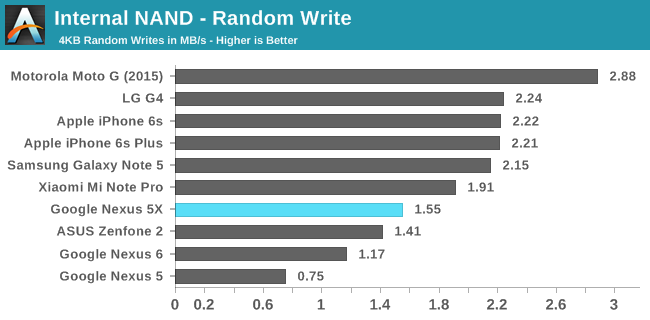
Random read and write speeds both take a hit when compared to the LG G4. While the gaps don't look enormous, the performance with small transaction sizes on mobile devices is hardly great to begin with, and so even these small gaps can matter greatly. In this case both random read and write speeds are both about 30% lower than the G4, which is significant.
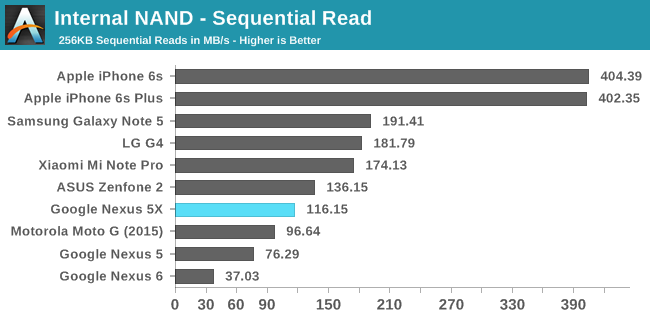
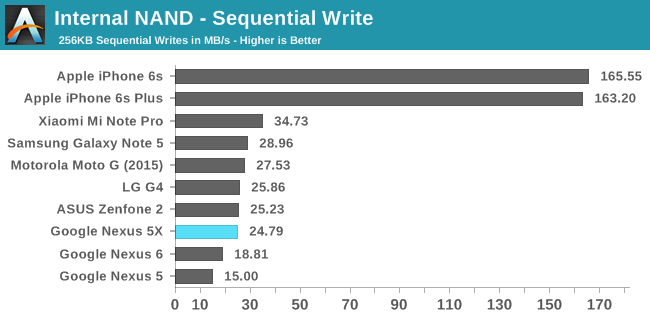
Sequential write speeds on the 5X end up being about equal to the G4, but the gap in sequential read speeds is enormous. Altogether, it's clear that there's still a significant reduction in NAND performance caused by the use of FDE when only using ARMv8's cryptographic instructions to encrypt and decrypt data to be written. This contrasts with comments made by Google engineer David Burke during a Reddit AMA discussing the FDE situation on the Nexus 5X in response to a comment that was referencing the Nexus 6's poor storage performance. What's interesting is that ARM has stated before that the ARMv8 cryptographic instructions are not a substitute for fixed-function hardware, and so it looks like there's a disagreement between ARM and Google on whether or not this is an adequate solution for encryption.
Reduced storage performance is not the only problem with this solution. Waking up the AP to do encryption or decryption every time the disk has to be read from or written to incurs a huge power penalty compared to simply using a hardware AES block and DMA which happens to be what Apple has been doing for about six years now. There are power savings here just waiting for Google to grab them, but they've decided not to do so for a second year now. Google certainly has an interest in getting Android phones to use FDE out of the box in order to combat negative perceptions about Android's security, but I don't think it's acceptable to have such a policy without the necessary hardware to make sure it doesn't affect the device's performance to any significant degree.
The Nexus 5X is certainly in a much better situation than the Nexus 6 was, but Google's FDE policy means you still get significantly reduced storage performance across the board compared to a device with the same NAND. This has various ramifications, ranging from data transfer speeds, to app install times, to performance when apps are updating in the background, to the ability to rapidly take photos and record high bitrate video. I really wish Google would either not ship with forced FDE and allow it to be disabled, or implement the necessary fixed-function AES hardware to avoid the significant performance hit.










197 Comments
View All Comments
Jojo99 - Monday, December 21, 2015 - link
Do you by chance have a 16GB model? And is everything lagging?I have a 32GB model and don't really notice any lagging at all. Don't have any lock-up problems either.
The camera is better than the Nexus 5 but still not great, especially in low light. Lot of noise. Highlights also often get blown out. Trying to understand why I am seeing EXIF info of ISO 60 in low light. Doesn't make sense.
Also like the LG Nexus 5, if you take a camera shot where the sun is in the frame, you'll get a small blue or green spot in the lower part of the shot.
The camera definitely not anywhere as good as my friend's iPhone 6 camera or my 8 year old Canon point and shoot..
Aloonatic - Tuesday, January 12, 2016 - link
I have the 32 GB model and it stalls, locks up, freezes, lags and apps crash often, with most apps I use, and when navigating system menus too.Performance wise, with general use, it's really no improvement over my 1st gen Moto G!
I've found that I've restarted this phone several times, 3 or 4 times a week at least. I wish I'd seen some of the comments here before buying one.
Aloonatic - Tuesday, January 12, 2016 - link
Why didn't I see your comment before I got one.I have no idea about the Nexus5 but my 5x has been a bit of a nightmare, and I replaced it as my Moto G was too slow and laggy, which I put down to it being 2 years old and lacking RAM, this is no better.
flyguy29 - Thursday, December 24, 2015 - link
I was under the belief that the Nexus devices were the flagship statement Google - collaborated smartphones... It's positioning as a "pure android" experience still does not address key touch points in overal consumer targets. But at least the mission statement is clear- a pure Android experience without any pretenses about superior screens, camera, etc- it's all about the fundamentals of a smart phone's functions and how a user engaged themAloonatic - Tuesday, January 12, 2016 - link
I got one of these after my 1st Gen Moto G started flagging and, frankly, I don't notice a great improvement in performance.-Sure, screen is bigger but the Moto Gs might have been small but it looked pretty good.
-The finger print senor is handy...
-However, it still stalls on unlocking all the time.
-Just trying to send a message can take 10s of seconds, and the keyboard often appears so you type, nothing happens, and then half a sentence appears in rapid fire.
-Switching between apps is still far too slow, and seems as slow as with my Moto G to me.
All in all, not a great deal of improvement over a cheap phone from a couple of years ago, which is pretty pathetic really, and seeing as this phone has more RAM and more horsepower under the hood you have to point the finger at Android OS itself, as others have mentioned.
blzd - Tuesday, January 19, 2016 - link
No performance issues on my 5x, runs as smooth as my N5 and gaming is not only faster, but the device runs considerably cooler while doing so.The camera and battery life are also big improvements over the N5.
If you have performance issues with your 5x look to your apps and services as the cause. Apps like Tasker and Snapchat have been known to be an issue. Also some users had issues restoring from a previous device and were able to resolve them by a factory reset without restoring.
Aloonatic - Sunday, February 7, 2016 - link
All I can say is that the N5 must have been terrible. Honestly, I have no axe to grind here(I've gone for a straight Nexus phone as I've tried every manufacturer out there and not been too impressed) , but this phone feels like a huge mistake to me.I am used to the normal smart phone cycle. 1st 6 months, great, everything is gravy. Then 6 to 18 months, it get gradually worse. THen the last 6 months are a grind where all you want to do is smash your phone into a million pieces as it's so slow and useless (even with factory resets etc, I'm not a muppet)
This phone feels like it's in the mid part of that cycle, so god knows what it'll be like at the endof my 24 month contract.
The battery is woeful, and I'm hardly a power user. I had to buy a car charger just to make it last the day.
I have only a handful of apps installed and they are all from major players, not a load kids making apps for fun and releasing them.
I have to power-cycle it multiple times each week.
It lags, it's slow, it's a mess.
Then the finger print scanner doesn't always work ,and the day dream mode fails all the time so it can't even work as a bed side clock when on charge any more.
It is no faster or smoother than my 2 year old Moto G.
Not worth the money.